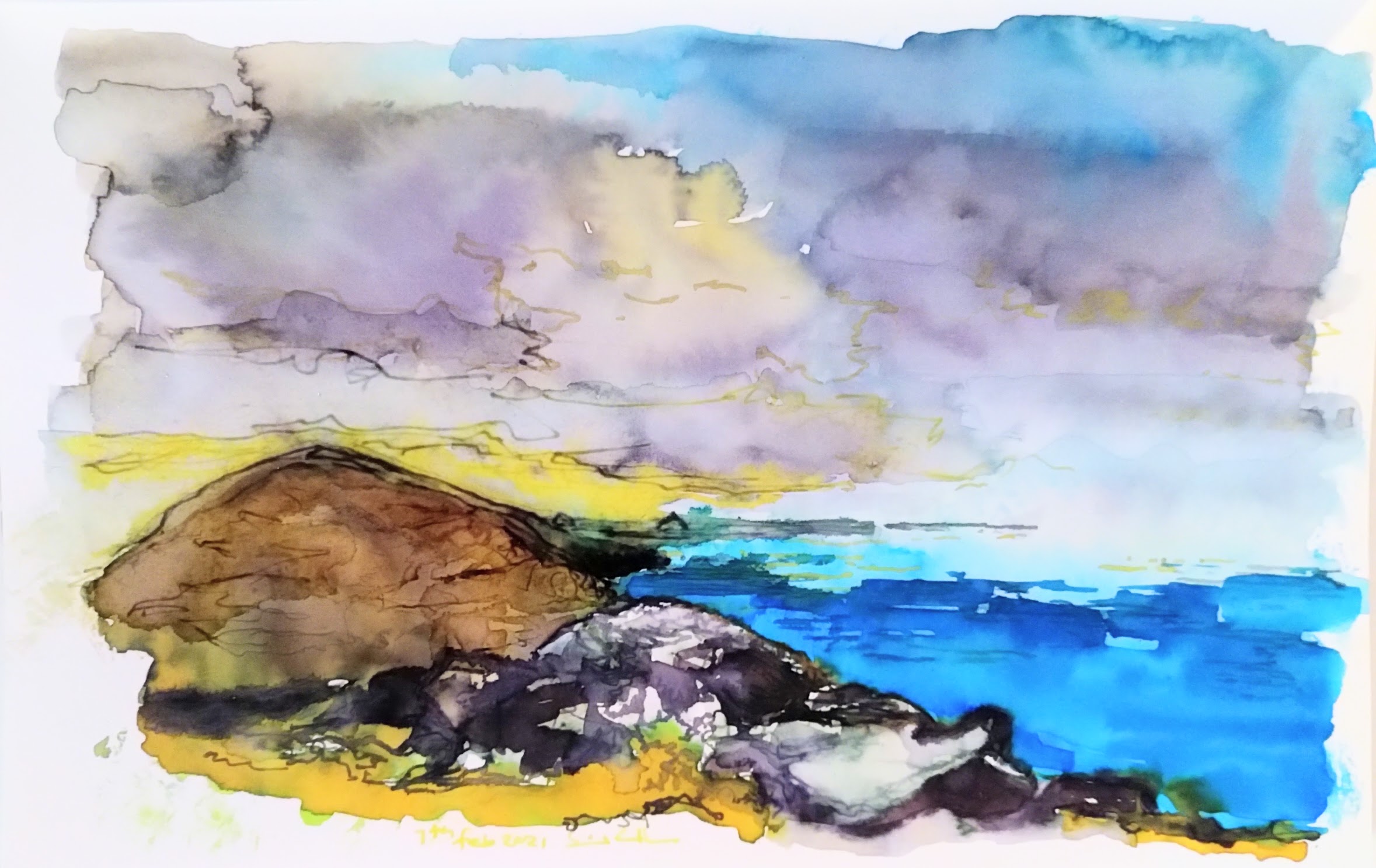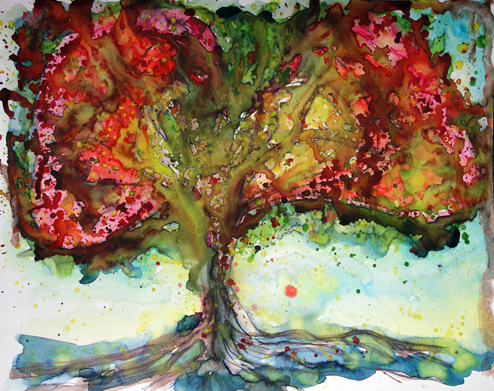How can a jellyfish change the way we look at the world?
I like that things are not always what they seem, that people change as we get to know them, landscapes evolve as we experience them through the seasons and what we think about certain aspects of our past and future can radically transform as we heal our stories about them.
This week I am exploring how aspects of science, activism and mysticism challenge our assumptions about the world and invite us to imagine our future, in yet unknowable ways.
Looking beyond separate and individual
Walking on Ballydonegan beach near Allihies a few weeks ago I saw about one hundred blue saggy balloon-like creatures that are often mistakenly described as jellyfish. They were Portuguese Man o War.
They are not individual entities but instead are a species of siphonophore which are made up of a colony of genetically identical individuals called zooid (clones) with various forms and functions, all working together symbiotically as one entity.
Each of the four parts of a man-o-war carries out a different task — floating, capturing prey, feeding, and reproduction. And the Portuguese Man-o-war is by no means the only symbiotic organism around.
I recently had the pleasure of being enlightened by Merlin Sheldrakes in his book ‘Entangled Life — how fungi make our worlds, change our minds and shape our futures’.
The chapter on lichen was a revelation. He described Lichen as a “living riddle…. that has provoked fierce debate about what constitutes an autonomous individual.” They “..confuse our concept of identity and force us to question where one organism stops and another begins.”
Lichens look like a plant but are neither a plant, an animal, nor a single organism. They are made up of a stable symbiotic association between fungi, algae and/or cyanobacteria. The algae and cyanobacteria provide sugars to the fungi via photosynthesis and the fungi provide the structure and long-term home for ‘them’.
Symbiotic relationships are all around us — there are about 200 subspecies of siphonophore, 13,500–17,000 identified Lichen species and most plants exist symbiotically with mycorrhizal fungi that are indistinguishable from their roots.
The mycorrhizal fungi provide the plant with phosphates and other nutrients that it extracts from the soil and the plant provides sugars to the fungi created via photosynthesis. Their relationship is so old that it has been proposed that roots may have evolved to mimic the mycorrhizal fungi!
And symbiotic relationships exist within us! Each of us holds up to 2 kilograms of bacteria (microbiota) in our gut. One-third of which is common to most people, while two-thirds are specific to each one of us: the microbiota in your intestine is like an individual identity card and very much a part of ‘who’ you are.
“It is no longer possible to conceive of any organism — humans included — as distinct from the microbial communities they share a body with. The biological identity of most organisms can’t be prised apart from the life of their microbial symbionts. Our bodies like those of all other organisms are dwelling places. Life is nested biomes all the way down.”
David Griffiths from ‘Queer theory for Lichens’
Looking beyond separation, we connect.
Looking beyond the gender binary
A lichen’s preferred pronoun might be ‘they’ and they offer ways for us to think beyond the narrow binary option. David Griffiths in his paper ‘Queer theory for Lichens’ states:
“…the identity of lichens is a question rather than an answer in advance. ….The Human binary view has made it difficult to ask questions that aren’t binary… We ask questions from the perspective of our cultural context. And this makes it extremely difficult to ask questions about complex symbioses like lichens because we think of ourselves as autonomous individuals and so find it hard to relate.”
Beyond science, Alok Vaid-Menon a gender non-conforming and transfeminine performance artist, educator, writer and comedian has received international attention for challenging the social construct of gender through fashion and poetry.
Through activism and visual art they challenge our ideas of sex and gender, they normalise gender-neutral language and teach about how binary gender is wrapped up in exclusive cultural ‘norms’ and is distinct from sex.
“Gender-neutral language isn’t about replacing an old norm with a new one. People have the right to self-determine their gender whether it be a man, woman, or nonbinary gender. The goal of gender-neutral language is to get rid of gender normativity, not everyone’s gender.” Alok Vaid-Menon, Beyond the Gender Binary
Looking beyond the gender binary, we include.
Looking beyond nouns
Another challenge to how we see the world arrives both from science and the mystics. You might identify as a human, a woman, a man or non-binary — as a noun of some sort, but you might also be described as a verb.
Merlin Sheldrake notes that “Lichens are stabilised networks of relationships; they never stop lichenising; they are verbs as well as nouns”.
We too are life arising through experiencing seeing, hearing, touching, imagining, walking and swimming.
The idea that we can be described as nouns and verbs has been understood and experienced in the mystical traditions for millennia and is described beautifully by Rabbi David Cooper as he describes the mystical experience of Jewish Kabbalah in his book ‘God is a verb’.
Looking beyond nouns, we transform objects into states of being.
Looking beyond assumptions
We name ‘things’ and categorise and sort them into order. We understand them in accordance with rules we created about the world and we achieve the sense that things are now ordered.
Seeing people, organisms and actions only from inside pigeonholes can, over time, lead to discrimination, racism and rigidity, limiting our capacity to see new options and solutions.
Having our assumptions challenged allows us to explore new ways of experiencing the world, opening us up to deeper connections and engaging more problem-solving bandwidth and giving us greater access to our creativity.
What would it look like to look beyond our current understandings and cultural assumptions of separation, nouns and gender? To include the idea that we live in a world that is profoundly woven together in sublime symbiotic adaptive relationships rather than being just separate individuals. To see that life around us can be seen both as nouns and verbs. And to expand beyond the binary of two genders to see gender as being a malleable and creative form of expression.
Looking only at an individual isolated entity one action seems to have limited effect, but in observing a system as a whole, we can see how a stimulus, like a set of dominoes, can lead to step changes, seismic shifts and explosions of creative energy.
“Financial crashes are a good example of this type of dynamic non-linear process, so are sneezes and orgasms.”
Merlin Sheldrake
Perhaps when we learn to see our world as an adaptive system, we can tap into great co-creative seismic shifts that we cannot begin to imagine now with our current smaller lens.
Looking beyond assumptions we open to new levels of creative possibilities.
Are we able to stand back?
Are you able to stand back, observe and accept that things can be very different from what you have learned; that our ideas about them can evolve? Can you, from time to time, let life be questions rather than answers known in advance?
Can you see the world around you without naming and categorising it? Watching the waves on the shore. Seeing birds in flight. Observing the ease and simplicity of life arising. The inter-relationships and the diversity of forms and expressions that arise and fall like a great dance.
Wishing you a beautiful week.



